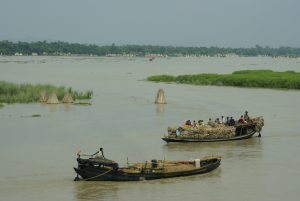On July 17, 2016, a huge stream of ice and rock tumbled down a narrow valley in the Aru Range of Tibet. When the ice stopped moving, it had spread a pile of debris that was up to 30 meters (98 feet) thick across 10 square kilometers (4 square miles). Nine people, 350 sheep, and 110 yaks in the remote village of Dungru were killed during the avalanche.
The massive debris field makes this one of the largest ice avalanches ever recorded. The only event of a comparable size was a 2002 avalanche from Kolka Glacier in in the Caucasus , explained Andreas Kääb, a glaciologist at the University of Oslo.
![Icefall marked in red [image by NASA]](/wp-content/uploads/2016/09/icefall_after.jpg)
The cause of the avalanche is unclear. “This is new territory scientifically,” said Kääb. “It is unknown why an entire glacier tongue would shear off like this. We would not have thought this was even possible before Kolka happened.”
Kääb’s preliminary analysis of satellite imagery indicates that the glacier showed signs of change weeks before the avalanche happened. Normally, such signs would be clues the glacier might be in the process of surging, but surging glaciers typically flow at a fairly slow rate rather than collapsing violently in an avalanche.
After inspecting the satellite imagery, University of Arizona glaciologist Jeffrey Kargel agreed that a surging glacier could not be the cause. “The form is completely wrong,” he said. “It must be a high-energy mass flow. Maybe liquid water lubrication at the base played some role,” he said.
Tian Lide, a glaciologist at the Chinese Academy of Sciences, visited the site in August and described the avalanche as “baffling” because the area where the ice collapse began is rather flat. “We failed to reach the upper part of the glacier for safety reasons,” he said in an email, “but we will go the upper part [later] to see if we can find some more hints about what caused the glacier disaster.”
References
- China Daily (2016, July 18) Nine killed by avalanche in Tibet. Accessed September 2, 2016.
- Nature (2016, August 23) Giant, deadly ice slide baffles researchers. Accessed September 2, 2016.
- Séries Temporelles (2016, August 25) Sentinel-2A captures a giant ice avalanche in Tibet. Accessed September 2, 2016.
- Séries Temporelles (2016, August 25) Updated: Sentinel-2A captures a giant ice avalanche in Tibet. Accessed September 2, 2016.
- UPI (2016, July 18) Avalanche kills nine in China’s Tibet. Accessed September 2, 2016.
NASA Earth Observatory images by Joshua Stevens, using Landsat data from the U.S. Geological Survey and Sentinel data from the European Space Agency. Special thanks to Simon Gascoin for locating the images. Image interpretation assistance by Andreas Kääb (University of Oslo), Tian Lide ( Chinese Academy of Sciences), and Jeffrey Kargel (University of Arizona). Caption by Adam Voiland.
This post originally appeared at the NASA Earthobservatory website.
![<p>The Aru Range as photographed before the avalance on 24 June 2016 [image by NASA]</p>](https://dialogue.earth/content/uploads/2016/09/icefall_oli_2016176_lrg-300x300.jpg)






